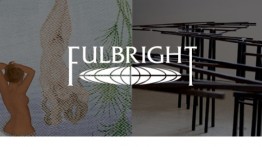Two Cooper Graduates Win Fulbrights
POSTED ON: July 10, 2014

Years before winning a Fulbright scholarship this May, Kanchan Wali-Richardson A’12 already knew that she wanted to study the contradictions of the city of Varanasi in eastern India: while it is the foremost pilgrimage site of Hinduism, Varanasi and its river, the Ganges, are exceedingly polluted.
“The infrastructure is collapsing with all the sewage, there are all these tannery factories upstream and it’s a huge disaster that India has been trying to figure out how to deal with for a long time,” says Wali-Richardson, a sculptor whose mother hails from Varanasi. “There hasn’t been a lot of progress and a lot of people are getting sick.”
In fact, the pollution of the Ganges is so infamous that the recently elected prime minister of India, Narendra Modi, made the contaminated river a central theme of his election, casting the Ganges as a symbol for government corruption.
Wali-Richardson wants to observe how devout Hindus, for whom the Ganges is a site of religious devotion and ritual, interact with environmentalists who are trying to contend with the 300 million liters of raw sewage and pollution from industry that flows into the river every day.
She doesn’t yet know what form her sculpture will take by the end of her nine months in Varanasi, but the steps that line the Ganges, known as ghats, will act as her starting point: “They’re amazingly beautiful, whole riverbanks lined with incredible cascading stairs.” To Wali-Richardson, the ghats represent users’ relationship to the river both for religious and industrial ends, and she will be searching for ways that sculpture can address those conflicting needs.
This year’s other Fulbright winner, Theresa Zeitz-Lindamood A’13, applied to travel to Bologna and Rome in order to investigate the work of 16th century painter, Lavinia Fontana. “I’m looking forward to meeting artists in Italy and learning about their artistic processes,” she says, “especially what it means to be working in the shadow of so many masterpieces.”
Zeitz-Lindamood works in egg tempera, which drew her to study the history of Italian painting and the uses of the medium. She learned about Fontana, a successful and prolific painter from Bologna who received many prestigious commissions and worked as a portraitist in the court of Pope Paul V. Like Zeitz-Lindamood, whose earlier work focused on all-female bathhouses of Japan, Fontana was intrigued by the communal lives of women. She became the leading portraitist of Bolognese noblewomen, and painted a now-lost canvas of an imagined meeting of female artists, philosophers, and poets of the era. Zeitz-Lindamood herself longs for a community of creative women to support each other and exchange ideas: “My project asks how such a community—whether linked across centuries or engaged in conversation firsthand—might provide support and inspiration for one another in a field historically dominated by men.”
She plans to paint a narrative cycle about Fontana’s life and work, and hopes to exhibit her paintings in Italy both as a way to introduce the Mannerist painter’s work to a larger audience and to speak to contemporary female artists searching for historic examples of women painters. Not surprisingly, Zeitz-Lindamood’s other hope for the year is to see Carlo Scarpa’s restoration of the Castelvecchio Civic Museum in Verona. “It explores the tensions between ancient and modern that my own Fulbright project is based on.”
Over the past 10 years, 16 Cooper Union students received Fulbright scholarships. Peter Buckley, Cooper’s Fulbright program advisor, says, “I think that it’s fair to say that a part of our reputation as a college is based on the number of Fulbrights we’ve had over the years.” Cooper’s standing is all the more impressive since the program’s funding has depleted over the years, making the prize even more competitive.




